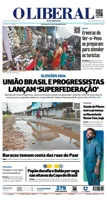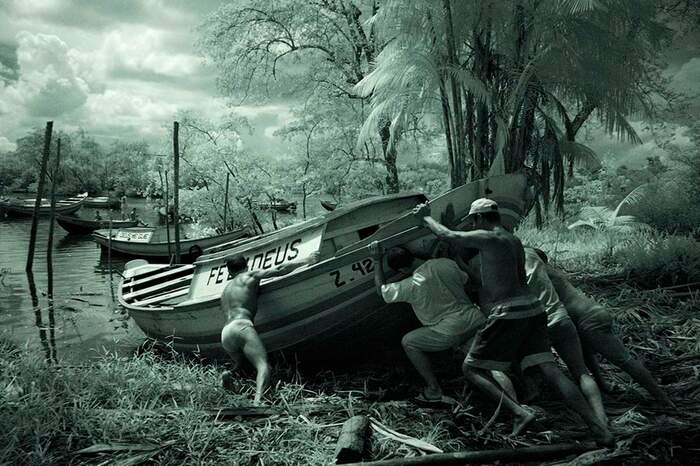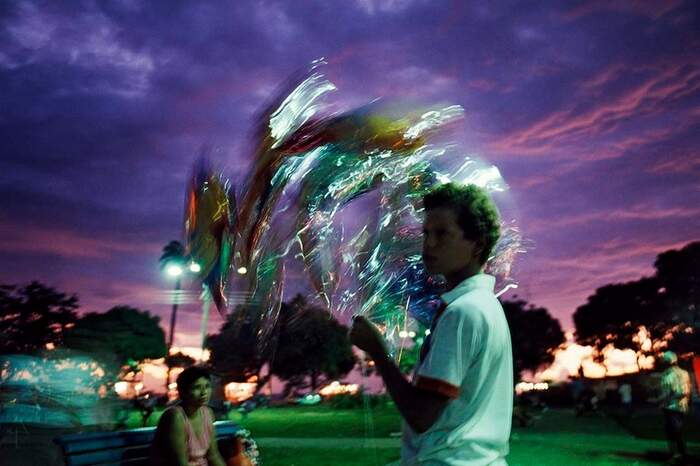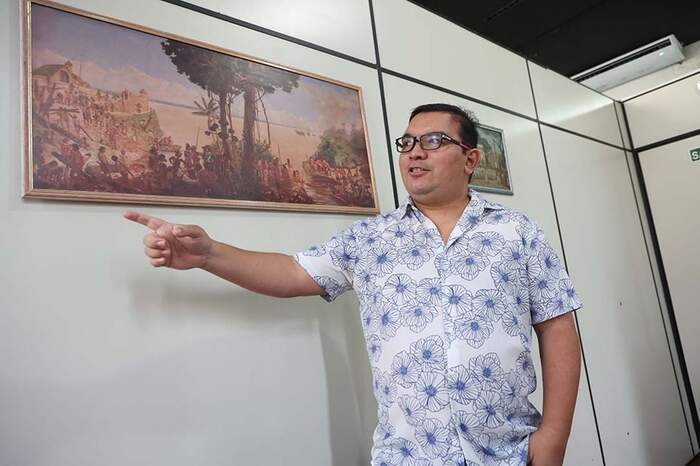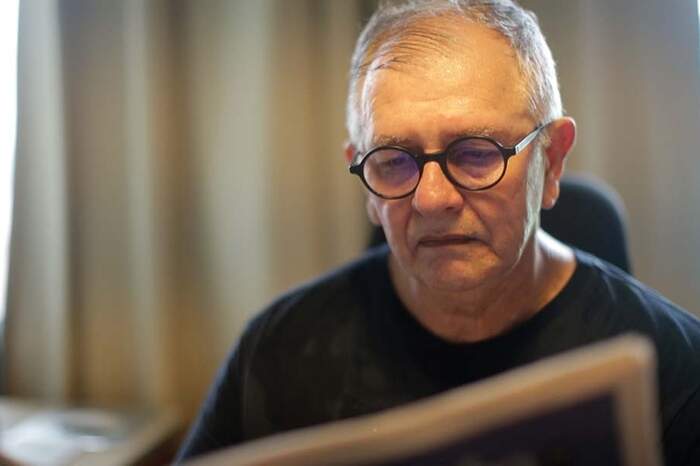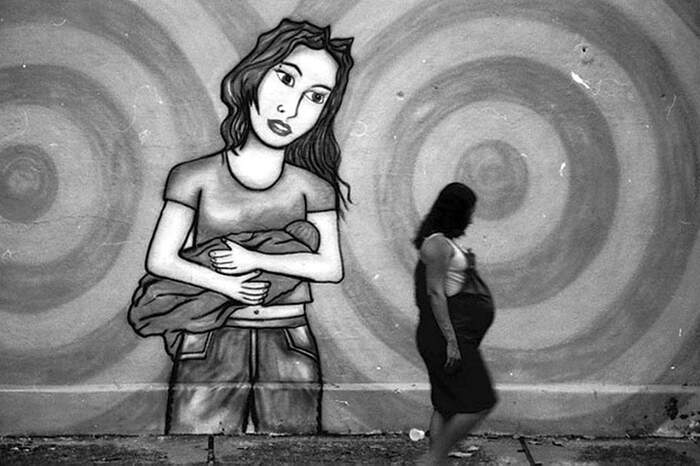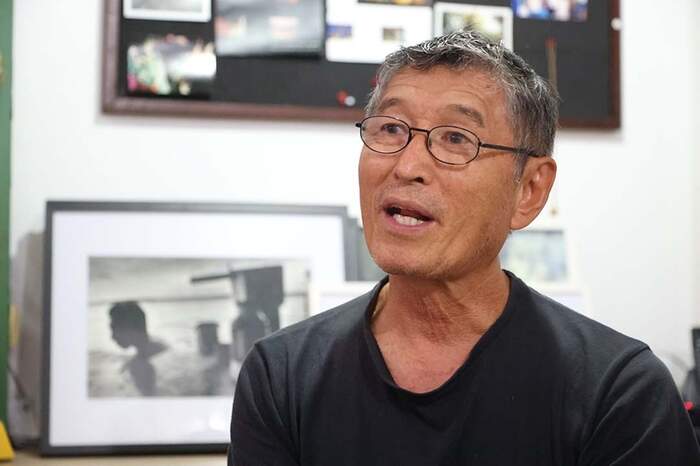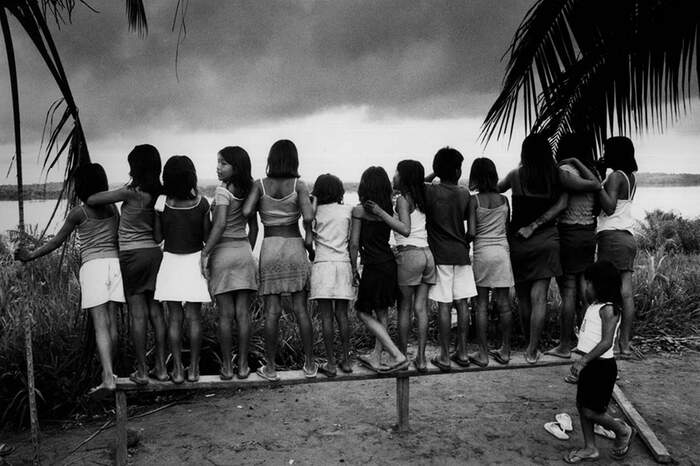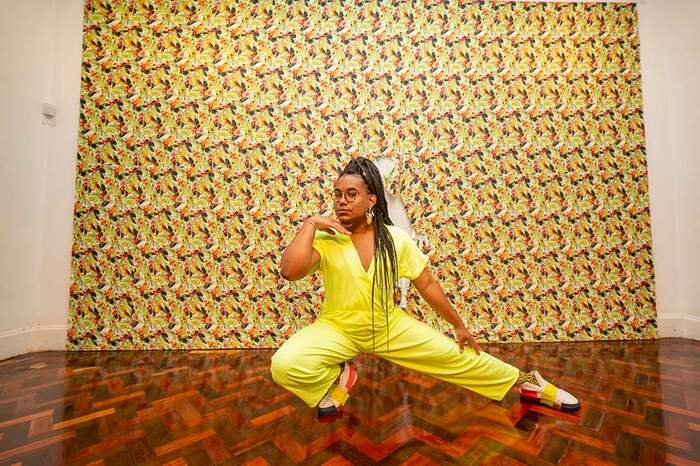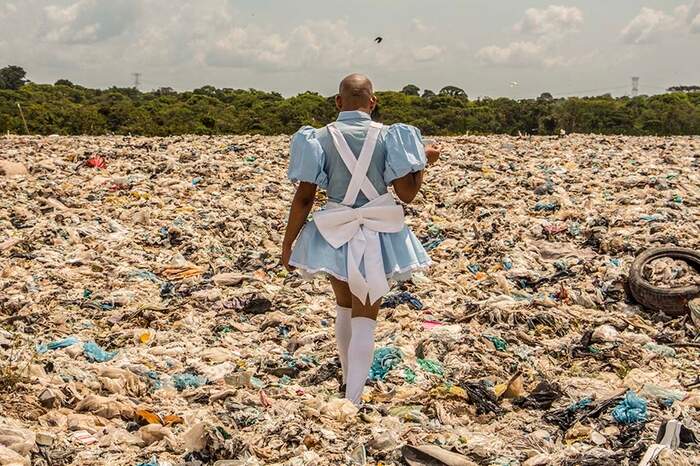Amazon: power of visual arts and literature
Whether as a source of inspiration or as a reference for creative transversalities, the region requires expressions capable of unfolding in the face of decolonial challenges. And recognition comes from the plurality of languages
The Amazon region is a source of inspiration and a reference for a myriad of artistic languages - whether for its lush landscape of dense forest, mighty rivers and biodiversity, or for its rich popular culture and its various convergences, including gastronomy, music, dance, customs and traditions. However, despite being the focus of global attention due to its environmental context, the region is not proportionally appreciated on its art, even though several celebrities from literature and visual arts linked to the region have gained increasing prominence in recent years within Brazil and worldwide.
Listen to the comment on this news:
“Historically, the Amazon distinguishes itself from the rest of the country. No wonder that, until the mid-eighteenth century, the state of Grão-Pará and Maranhão was separate from the state of Brazil. This is part of a political integration project that, in fact, never took place”, points out historian and photographer Michel Pinho, Master in Communication, Culture and Languages. “From an artistic point of view, the South and Southeast is a recognized axis (in Brazil) whereas we, up here in the Amazon, are seen almost as foreigners”, ponders Pinho.
The historian recalls that, from the 19th century onwards, changes in the scenario were translated in a greater capacity for communication and diffusion of the local production by authors and artists in the region. “It is interesting to observe that people who break this barrier, such as the authors Inglês de Sousa (1853-1918), Dalcídio Jurandir (1909-1979) and more recently Edyr Augusto Proença, the photographer Luiz Braga and visual artists Emannuel Nassar and Luciana Magno, in some way, talk about the history of the Amazon and the local perspective, however, in such a way that it represents global desires and aspirations. This is very interesting because, from a political and artistic point of view, they ensure an important space of visibility to talk about the region elsewhere”.
Even so, Paulo Nunes, writer and poet, professor and researcher at the University of the Amazon (Unama) and PhD in Letters, ponders, the prejudice against the local literary production, an example of the "diverse forms of coloniality" exerted on the Amazon territory, turned the region into an island. “The Amazon is treated as ‘exotic’ or as a consumer product which pleases the interests of national and international capital. For example, literature produced in the wide North of Brazil, I believe, is underrated, unknown to the average Brazilian reader. And if we take this to the global scene, the issue becomes even more diluted and pulverized”.
Nunes reflects on Amazonian authors who achieved international prominence. He recalls that Dalcídio Jurandir, the marajoara author had his work published in Russian in the mid-twentieth century and “Belém do Grão-Pará”, written by the same author, had two Portuguese editions. Benedicto Monteiro (1924-2008) is studied in Germany, just as is Dalcídio. “Milton Hatoum has his work published in many languages and dialects. Vicente Franz Cecim has broken through the blockade and is known in Portugal. Age de Carvalho is known outside Portuguese-speaking countries. Antônio Moura is perhaps our best-known contemporary poet in Europe. Max Martins had his writings translated into English. The most famous author from Pará is probably Edyr Augusto Proença, widely read in French. But, in general, let us not be deluded, the literature produced here is outside the Brazilian and the Western-canon (classical arts, especially European ones)”.
Creative power dodges colonialities
The prejudice against the Amazonian artistic production, emphasizes Paulo Nunes, is seen as a barrier to be overcome. The scholar remarks that in literature authors believe in efforts towards independent publications, alternative publishers, online platforms, incentive laws, fairs and literary meetings. In addition, Paulo Nunes highlights the important role of the “poetry slams” (poetry competitions) carried out on the outskirts of cities like Belém, which stimulate artistic production and art dissemination, especially among young people.
Nunes recalls that, in this struggle for recognition, it is even necessary to abandon false dilemmas and ideas, such as the one stating that Amazonian literature must necessarily reflect the Amazon itself in order to be recognized outside the region. He advocates that this approach is also a “form of colonial tradition”, which “is perpetuated until today” and creates expectations concerning Amazonian authors. This cultural stereotype is broken down when readers are taken by surprise when they come across recent works, such as 'Pssica', by Edyr Augusto, and 'Pedral do Inferno', by Salomão Larêdo, or a poem by Giselle Ribeiro and Shaira Mana Josy. “Readers are, then, compelled to ask themselves: 'Are these people really Amazonian writers? Is this really from here? ” says Nunes.
“Emmanuel Nassar, Dalcídio Jurandir, Luciana Magno and Edyr Augusto have the Amazon as a backdrop, but, in fact, it reveals a very Brazilian reality. This is very important to show that this speech comes from a certain place. We have a place in the history of this country and a motivation to make a different country, a plural Brazilian nation”, asserts Michel Pinho.
In addition to addressing the Amazon theme, the legitimate representation of the so-called "original peoples" in the world of arts is currently highlighted. A good example is Daniel Munduruku, an indigenous writer, who is one of the finalists for the Jabuti Prize this year, the largest national literary award, granted by the Brazilian Book Chamber. “It’s definitely amazing to have a representation of the native Amazonian peoples achieving such a prominent position. It is a model of innovative artistic production that is here to stay”, celebrates Pinho.
“Indigenous voices have always been muffled (...) Daniel Munduruku and Ailton Krenak are the most prominent examples, but I am very pleased to see Márcia Waina Kambeba's literature work. The literature native peoples produce represent a great movement that questions the Western canon, bringing new aesthetic forms of representation, beyond the colonialities”, evaluates Nunes.
“Invisible”, writers from the Amazon want to overcome barriers
“We face local and national difficulties. It seems that there is a kind of wall between us, from the North, and the people from the South and Southeast [of Brazil], where the big media is settled", says Edyr Augusto, the writer from Pará who was "discovered" by the press and by literary fairs in the Southeast region, after winning the Caméleon Prize for best foreign book in France: “Os Éguas”, in 2015. Edyr was hired by a national company and has published works in France and England. “I pierced a bubble,” says Edyr.
“The French say that I break the crystal of a hedonistic Amazon, of dreams, and show that we have the same problems they do in big cities. I'm talking about the largest rainforest in the world, which also has a concrete made urban forest with 2 million inhabitants – Belém. I write about the perplexity of this contrast. My books have everything that other books have, what makes them different is the way they write and portray the Amazon”.
“It is as if we did not exist to the rest of Brazil, especially to the axle Rio de Janeiro – São Paulo, or they just see us in a reduced way, as in a crystallized…stereotyped way”, says Monique Malcher, a writer from Pará state, whose book, “Flor de Gume”, was nominated as a finalist to the Jabuti Literature Award this year, within the “short story category”. She shows off her happiness for having accomplished that position. “We are seen by some Brazilians through a perspective that shows they don’t not really know Brazil”, she says.
Lately, the writer has mingled among reading clubs, which have helped her to promote her books. Now, she hopes that the window provided by the award, can also put other female writers from the Amazon in evidence. “50 years ago, the winner of Jabuti Award was Olga Savary (1933 – 2020). It’s important to also mention those who are gone, but still remain here through their words, we must also motivate more women from the Amazon region to occupy those spaces”, she states.
The teacher and writer from Manaus state, Milton Hatoum, is no doubt a renowned reference for the current national and international literature. He has won many awards; however, he does not necessarily write exclusively about themes related to the Amazon region. He has been awarded a Jabuti prize three times in the category “romance”: in 1989, he was awarded for the book “Relato de um certo Oriente”; in 2000, he won the third prize for the book “Dois irmãos”; and in 2006, he won an award again for the book “Cinzas do Norte”.
Salomão Larêdo is another important writer and journalist from Pará, who holds a master’s degree in Literature Theory. He has won many literature awards, likewise he is known for delighting his readers with Amazonian themes. He was raised next to the Tocantins river, in the Amazon rainforest, municipality of Cametá, in Pará state. In his books, often themed about the Amazon region, he writes using ordinary language, representing the language spoken by the local people. “I write about themes related to my people, thus, those issues naturally spread to the other parts of Brazil and also to the world, reaching universal interest, as they are all about the human nature”, he explains.
"One who writes literature in the Amazon region must have a side labor activity" - Ivanildo Alves, president of Academia Paraense de Letras [Letters Academy from Pará]
Larêdo states that due to his long experience in literature, he knows it is not an easy task to be a writer in the Amazon. “Our culture is undervalued. Our literature is not familiar to many people. We have faced aesthetic, cultural and political dilemmas for such a long time, traits of Brazilian society. We shall not bow down passively to this anymore as if we did not exist as writers”, he emphasizes.
He hopes one day the writers from the Amazon will finally be recognized in the Brazilian literature scenario. Larêdo remarks nowadays, the writers “spend more than they earn for writing, editing and publishing their books”, however, “they keep on writing, because they always hope that tomorrow there will be people interested in reading what they have written, regardless this cultural and educational blackout that we still experience”.
Ivanildo Alves, a teacher and lawyer, who is also the president of Academia Paraense de Letras [Letters Academy from Pará], remarks that writers from Pará cannot make a living from that art-profession. He notes that the public policies regarding literature, even though important, are not enough. “The books about our Amazonian life, despite their great quality, are usually produced by the authors themselves. One who writes literature in the Amazon region must have a side labor activity”, he says.
The forest that pulsates in the visual arts
From the great forest crossed by rivers, to the urban sightseeing or riverine populations, the Amazon region is a handful to the visual artists, both in terms of registering reality and also in having the region as a reference. The photographer Miguel Chikaoka’s work is a good example of such visual potential in the Amazon. Besides the scenarios, the experience of living in the region influences the view of professionals who pass by.
As a result of the experience that begun in photojournalism, in the early 1980s decade, Chikaoka has become an educator and opened an institute that until today is responsible for providing professional training to new photographers in the state, named Associação Fotoativa [Fotoativa Association].
Chikaoka emphasizes that this landmark in the Amazonian photography trajectory is linked to a national movement – the creation of Instituto Nacional de Fotografia [National Institute of Photography], which promoted a traveling art event around Brazil. Moreover, he also highlights other actions, such as the creation of “Salão Arte Pará” exhibition, which included internationally renowned names in art curatorship in its jury committee. Those actions helped the visual arts movement in the Amazon to reach up beyond the borders of the region.
“I think there is a plural issue aimed at gathering people together from different professional backgrounds, in arts as well as in other professional fields, such as historians, engineers, architects”, ponders Chikaoka. This initiative evidences the important role of the artist collectives in the Amazon. The exchange of experiences and practices result in diverse perspectives of a unique identity, that have started to bring together inspirations from multiple experiences permeating the peoples from the Amazon”, he says.
“Noite Suja” [Dirty Night], a group of artists that uses Drag Queen “doing” is one of those collaborative groups that have started a new stage, searching for that language matching performance, photography and visual arts in general. Rafael Bqueer, a representative of that movement, is currently involved in the production of a documentary about the history of the group. The project is being developed sponsored by a grant provided by Instituto Moreira Salles [Moreira Salles Institute].
Also representing the new groups of artists that show the image of the Amazon contemporaneous art to the world, Rafael has worked recently for Arte Pará 2021 exhibition. He has held national and international exhibitions, such as the collaborative work entitled “Against, Again: Art Under Attack in Brazil”, at Anya & Andrew Shiva Gallery, in New York city, in 2020, and the individual work entitled “UóHol”, at the Museu de Arte do Rio [Art Museum from Rio de Janeiro], in 2020.
Graduated from the Universidade Federal do Pará (UFPA) [Federal University of Pará], Rafael states the importance of marking this territory with his work. “UFPA has professors engaged in social actions and policies that help us to figure out how the Amazon region can go beyond the colonial perspectives”, he says, highlighting the importance of professor Zélia Amador de Deus during his process of understanding himself as an Amazonian black person.
Currently, Rafael lives in São Paulo. “The institutional circulation throughout the Southeast has progressively helped me understand where belong to, in fact, as a person with an Amazonian identity. Not only concerning the racial issue, but also with reference to other aspects I research a lot about – issues related to gender and sexuality”, he explains.
Through the windows of the cinema
Besides the photography and other visual arts productions, The Amazon also is expressed in the cinematographic art. “Iracema – Uma Transa Amazôniza”, a film by Jorge Bodanzky, in 1975, offered to the world a kind of self-portrait of the population that lives next to the Transamazônica highway – a 5,6-thousand-kilometer road which crosses the forest. The road is turning 50 years old in 2022. Currently, Bodanzky is being honored with an exhibition in Belém, at the Ruy Meira Gallery, in the Casa das Artes Museum [House of Arts].
“Bodanzky: notas de um Brasil profundo” [Bodanzky: notes of a deep Brazil] portrays the filmmaker’s view, revealing that no significant changes have occurred during the last decades in this region. Internationally awarded, Bodanzky evaluates how important it is for Brazilians to get to know the Amazon. “It is something different”, he says, referring to how the country views the Amazon nowadays, compared to the period when “Iracema – Uma Transa Amazônica” was premiered. “At the time, not much was known. Actually, people did not use to travel to the countryside of Brazil. Now they do! But only to touristic spot resorts. Thus, it does not aggregate knowledge”, he affirms.
Palavras-chave
COMPARTILHE ESSA NOTÍCIA



